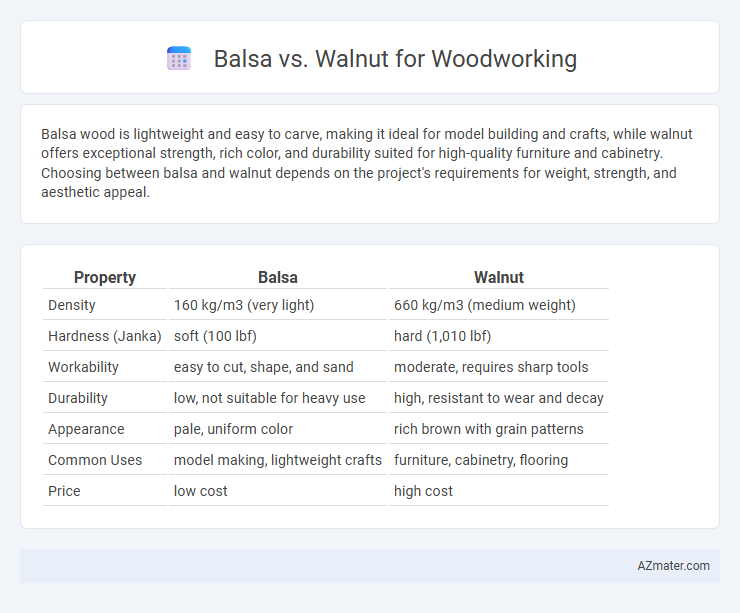Balsa wood is lightweight and easy to carve, making it ideal for model building and crafts, while walnut offers exceptional strength, rich color, and durability suited for high-quality furniture and cabinetry. Choosing between balsa and walnut depends on the project's requirements for weight, strength, and aesthetic appeal.
Table of Comparison
| Property | Balsa | Walnut |
|---|---|---|
| Density | 160 kg/m3 (very light) | 660 kg/m3 (medium weight) |
| Hardness (Janka) | soft (100 lbf) | hard (1,010 lbf) |
| Workability | easy to cut, shape, and sand | moderate, requires sharp tools |
| Durability | low, not suitable for heavy use | high, resistant to wear and decay |
| Appearance | pale, uniform color | rich brown with grain patterns |
| Common Uses | model making, lightweight crafts | furniture, cabinetry, flooring |
| Price | low cost | high cost |
Introduction to Balsa and Walnut Wood
Balsa wood is renowned for its exceptional lightness and low density, making it ideal for model building and lightweight craft projects where easy carving and shaping are essential. Walnut wood is prized for its rich, dark hues and strong, durable nature, often used in fine furniture, cabinetry, and high-end woodworking for its smooth finish and excellent dimensional stability. Understanding the fundamental properties of balsa and walnut helps woodworkers select the right material based on project requirements such as strength, weight, and aesthetic appeal.
Physical Properties Comparison
Balsa wood is significantly lighter and softer, with a density ranging from 0.1 to 0.2 g/cm3, making it ideal for lightweight projects and easy carving, while walnut is much denser, typically 0.6 to 0.7 g/cm3, providing superior strength and durability for furniture and cabinetry. Walnut's hardness averages around 1,000 on the Janka scale, offering excellent resistance to dents and wear, whereas balsa scores approximately 100, highlighting its softness and limited structural use. Moisture content impacts both woods differently; walnut maintains stability with moderate moisture, but balsa's lightweight structure is more susceptible to warping and compression under pressure.
Weight and Density Differences
Balsa wood is extremely lightweight with a density of approximately 160 kg/m3, making it ideal for projects requiring minimal weight and easy handling. Walnut, in contrast, has a higher density around 640 kg/m3, offering greater strength and durability but at a significantly heavier weight. The substantial density difference impacts material choice depending on whether a lightweight or robust wooden component is prioritized in woodworking.
Workability and Machining
Balsa wood is renowned for its exceptional workability due to its lightweight and soft texture, making it easy to cut, carve, and shape with minimal effort, ideal for intricate woodworking projects and prototypes. Walnut, while denser and harder, offers superior machining precision and holds detail well, but requires sharper tools and slower feed rates to avoid tear-out. Both woods excel in specific applications; balsa's softness enables rapid hand and machine shaping, whereas walnut's robust grain and durability provide a refined finish with complex machining tasks.
Strength and Durability
Walnut wood offers superior strength and durability compared to balsa, making it ideal for furniture and structural woodworking projects that require long-lasting material. Balsa is significantly lighter and softer, providing ease of shaping but lacking the robustness needed for heavy-duty applications. For projects requiring high resistance to wear and impact, walnut's dense grain and hardness outperform balsa's delicate fiber structure.
Aesthetic Qualities and Grain Patterns
Walnut showcases rich, deep brown hues with striking, swirling grain patterns that enhance the elegance of high-end woodworking projects. Balsa features a lighter, creamy tone with a more uniform and subtle grain, making it ideal for lightweight applications where a clean, minimalist look is preferred. The contrasting aesthetic qualities position walnut as a premium choice for decorative pieces, while balsa is favored for functional, less ornate designs.
Common Uses in Woodworking
Balsa wood is prized in woodworking for its exceptional lightness and ease of shaping, making it ideal for model building, prototypes, and lightweight crafts. Walnut stands out for its rich color, durability, and fine grain, commonly used in premium furniture, cabinetry, and decorative veneers. Both woods serve distinct purposes, with balsa favored for delicate, lightweight projects and walnut chosen for elegant, structurally demanding applications.
Cost and Availability
Balsa wood is significantly less expensive and more readily available than walnut, making it a popular choice for budget-conscious woodworking projects. Walnut, known for its rich color and durability, commands a higher price and is often sourced from specialty suppliers due to its limited availability. The cost difference between balsa and walnut reflects not only the material properties but also the market demand and harvesting limitations.
Sustainability and Environmental Impact
Balsa wood, known for its lightweight and rapid growth, offers a highly sustainable option due to its fast regeneration rate and minimal environmental footprint during harvesting. Walnut, while prized for its durability and rich aesthetic, grows slower and requires more resources, leading to greater environmental impact and concerns about deforestation. Choosing balsa supports eco-friendly woodworking by prioritizing renewable resources, whereas walnut necessitates responsible sourcing to mitigate ecological damage.
Choosing the Right Wood for Your Project
Balsa wood is lightweight, easy to cut, and ideal for prototype models or lightweight crafts, while walnut offers durability, rich color, and fine grain suited for high-end furniture and detailed woodworking projects. Choosing the right wood depends on the project's requirements for strength, aesthetics, and workability: balsa excels in projects needing lightness and ease of shaping, whereas walnut provides robustness and a polished appearance. Understanding these characteristics ensures optimal material selection for woodworking with considerations for long-term durability and visual appeal.

Infographic: Balsa vs Walnut for Woodworking
 azmater.com
azmater.com